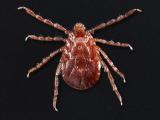A University of North Carolina (UNC) at Chapel Hill modeling study suggests that wild-habitat disruption may be contributing to the increasing US prevalence of Alpha-gal syndrome (AGS), a tick-borne allergy to animal meat.
The study team used a dataset of 462 AGS patients with confirmed AGS from UNC Health and models based on environmental factors, such as landcover and topography, to assess whether the risk of AGS is linked to the habitat fragmentation often seen in open spaces and areas of low-density development in North Carolina, South Carolina, and Virginia.
Their findings were published this week in PLOS Climate.
Symptoms occur after eating meat
In the United States, AGS is most often associated with the lone star tick (Amblyomma americanum) but can also be transmitted by black-legged ticks (Ixodes scapularis, also called deer ticks). It has a particularly high incidence in the mid-Atlantic region. The number of suspected cases rose from 24 in 2009 to more than 34,000 in 2019.
Named after the galactose-α-1,3-galactose molecule present in most mammals, AGS typically causes symptoms 2 to 6 hours after the consumption of meat or other animal products.
Symptoms can range from mild to life-threatening and may include hives or rash, nausea/vomiting, stomach cramps, heartburn, diarrhea, low blood pressure, swelling, dizziness/fainting, and cough or shortness of breath. Most people with AGS need to refrain from eating meat such as beef, pork, lamb, venison, and rabbit.
Human encroachment, climate change
The models identified open-space development and low population density as risk factors for AGS. Two models predicted a strong east-to-west risk gradient across the mid-Atlantic region, which largely reflects the environmental transition from mountains to coastal plains, while a third model predicted a much more uneven distribution.
As low-intensity development has continued throughout the US, humans have encroached on tick habitat, while tick ranges have expanded due to climate change.
"These results provide evidence that AGS is associated with land uses that are associated with habitat fragmentation, the preferred habitat of Am. Americanum," the authors wrote. "This information can be used to inform future education programs aimed at reducing AGS incidence in the region."
The distribution of alpha-gal cases throughout the United States doesn't perfectly align with the known distribution of lone star ticks, suggesting potential environmental confounders and/or ascertainment bias, the researchers said. But estimating incidence and geographic case distribution is complicated by limited reporting (AGS is not generally reportable at the federal level) and low healthcare provider awareness of the condition.
"AGS incidence, like all TBD [tick-borne disease], is largely driven by human behaviors that increase human-tick interactions, e.g., land use change, as opposed to tick population dynamics," they wrote. "Anthropogenic land use change, such as forest fragmentation and urbanization in particular, have been linked to increased TBD risk."
"As low-intensity development has continued throughout the US, humans have encroached on tick habitat, while tick ranges have expanded due to climate change," they added.




















